1997 GMC SIERRA service
[x] Cancel search: servicePage 280 of 436

Some gasolines that are not reformulated for low
emissions contain
an octane-enhancing additive called
methylcyclopentadlenyl manganese tricarbonyl
(MMT);
ask your service station operator whether or not his fuel
contains
"T. General Motors does not recommend the
use of such gasolines.
If fuels containing MMT are used,
spark plug life may
be reduced and your emission control
system performance may
be affected. The malfunction
indicator lamp on your instrument panel may
turn on. If this
occurs, return to your authorized GM dealer for service.
To provide cleaner air, all gasolines in the United States
are now required to contain additives that
will help prevent
deposits from forming
in your engine and fuel system,
allowing your emission control system to function
properly. Therefore, you should not have to add anything
to the fuel. In addition, gasolines containing oxygenates,
such
as ethers and ethanol, and reformulated gasolines
may
be available in your area to help clean the air. General
Motors recommends that you use these gasolines
if they
comply
with the specifications described earlier.
NOTICE:
Your vehicle was not designed for fuel that
contains methanol. Don't use it. It can corrode
NOTICE: (Continued)
I NOTICE: (Continued) I
metal parts in your fuel system and also damage
plastic and rubber parts. That damage wouldn't
be covered under your warranty.
Fuels in Foreign Countries -- Gasoline
Engines
If you plan on driving in another country outside the
United States or Canada, the proper fuel may be hard
to find. Never use leaded gasoline or
any other fuel not
recommended
in the previous text on fuel. Costly repairs
caused
by use of improper fuel wouldn't be covered by
your warranty.
To check on fuel availability, ask an auto club, or
contact
a major oil company that does business in the
country where you'll be driving.
You can also write us
at the following address for
advice. Just tell
us where you're going and give your
Vehicle Identification Number (VIN).
General Motors International Product Center 1908 Colonel Sam Drive
Oshawa, Ontario
L 1 H 8P7
6-4
ProCarManuals.com
Page 294 of 436
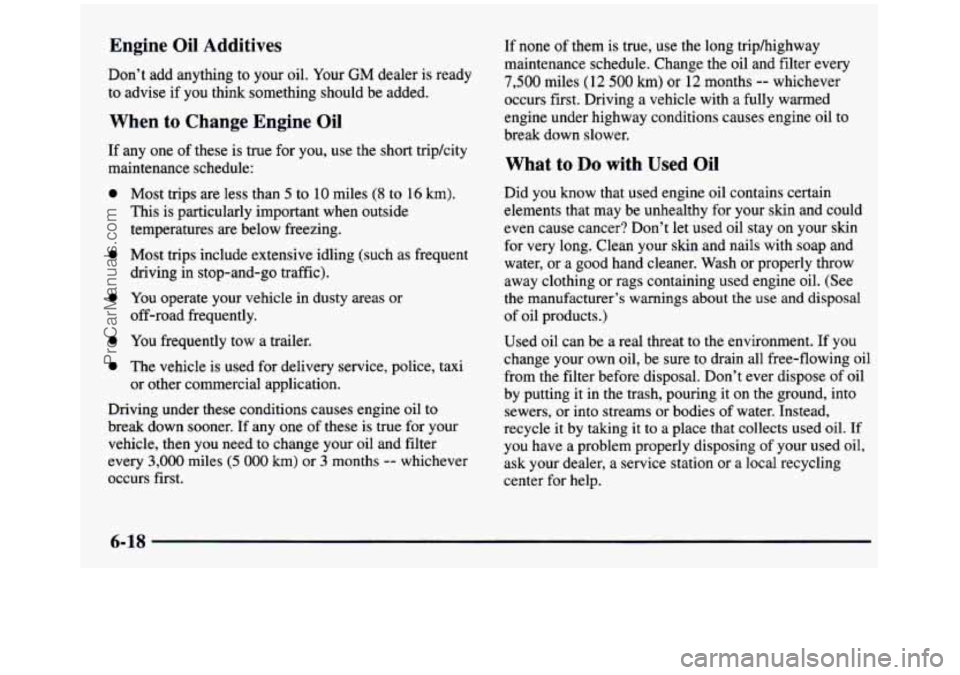
Engine Oil Additives
Don’t add anything to your oil. Your GM dealer is ready
to advise if you think something should be added.
When to Change Engine Oil
If any one of these is true for you, use the short tripkity
maintenance schedule:
0
0
0
0
0
Most trips are less than 5 to 10 miles (8 to 16 km).
This is particularly important when outside
temperatures
are below freezing.
Most trips include extensive idling (such as frequent
driving in stop-and-go traffic).
You operate your vehicle in dusty areas or
off-road frequently.
You frequently tow a trailer.
The vehicle is used for delivery service, police, taxi
or other commercial application.
Driving under these conditions causes engine oil to
break down sooner. If any one of these is true for your
vehicle, then you need to change your oil and filter
every
3,000 miles (5 000 km) or 3 months -- whichever
occurs first. If
none
of them is true, use the long triphighway
maintenance schedule. Change the oil and filter
every
7,500 miles (12 500 km) or 12 months -- whichever
occurs first. Driving
a vehicle with a fully warmed
engine under highway conditions causes engine oil to
break down slower.
What to Do with Used Oil
Did you know that used engine oil contains certain
elements that may be unhealthy for your skin and could
even cause cancer? Don’t let used oil stay on your skin
for very long. Clean your skin and nails with soap and
water,
or a good hand cleaner, Wash or properly throw
away clothing or rags containing used engine oil. (See
the manufacturer’s warnings about the use and disposal
of oil products.)
Used oil can be a real threat to the environment.
If you
change your own oil, be sure to drain all free-flowing oil
from the filter before disposal. Don’t ever dispose of oil
by putting it in the trash, pouring it on the ground, into
sewers, or into streams or bodies of water. Instead,
recycle
it by taking it to a place that collects used oil. If
you have a problem properly disposing of your used oil,
ask your dealer, a service station or a local recycling
center for help.
6-18
ProCarManuals.com
Page 295 of 436
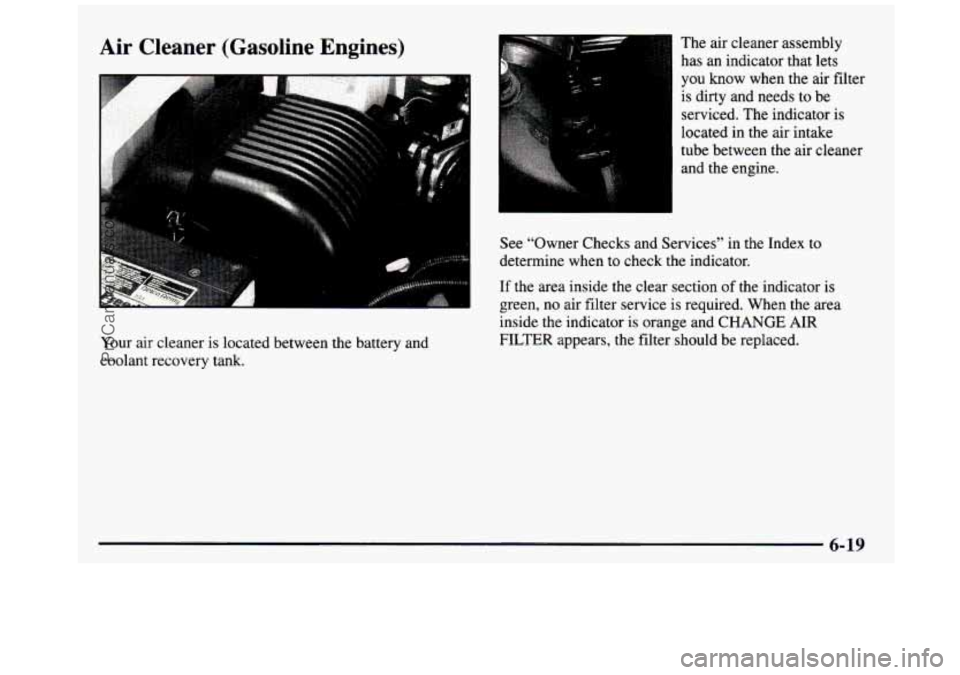
Air Cleaner (Gasoline Engines)
Your air cleaner is located between the battery and
coolant recovery tank. The
air cleaner assembly
has an indicator that lets
you know when the air filter
is dirty and needs to be
serviced. The indicator
is
located in the air intake
tube between the air cleaner
and the engine.
See “Owner Checks and Services” in the Index to
determine when to check the indicator.
If the area inside the clear section of the indicator is
green, no air filter service is required. When the area
inside the indicator is orange and
CHANGE AIR
FILTER appears, the filter should be replaced.
6-19
..
ProCarManuals.com
Page 296 of 436
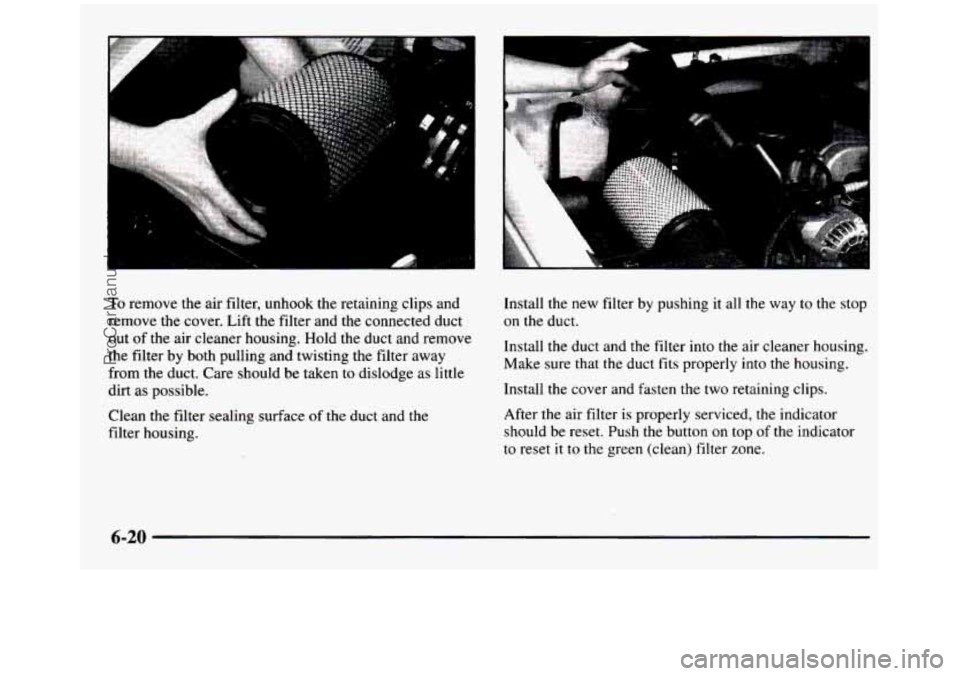
To remove the air filter, unhook the retaining clips and
remove the cover. Lift the filter and the connected duct
out of the air cleaner housing. Hold the duct and remove
the filter by both pulling and twisting the filter away
from the duct. Care should be taken
to dislodge as little
dirt as possible.
Clean the filter sealing surface
of the duct and the
filter housing. Install
the new filter
by pushing it all the way to the stop
on the duct.
Install the duct and the filter into the air cleaner housing.
Make sure that the duct fits properly
into the housing.
Install the cover and fasten the two retaining clips.
After the air filter is properly serviced, the indicator
should be reset. Push the button on top of the indicator
to reset
it to the green (clean) filter zone.
6-20
ProCarManuals.com
Page 297 of 436
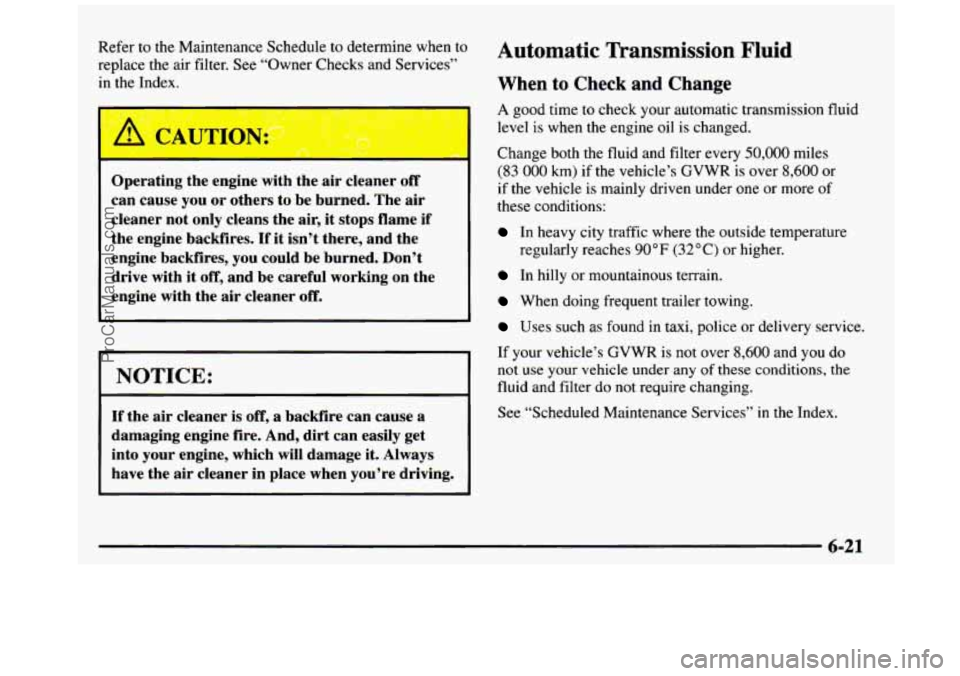
Refer to the Maintenance Schedule to determine when to
replace the air filter. See “Owner Checks and Services”
in
the Index.
Operating the engine with the
air cleaner off
can cause you OF others to be burned. The air
cleaner not only cleans the air,
it stops flame if
the engine backfires.
If it isn’t there, and the
engine backfires, you could be burned. Don’t
drive with it
off, and be careful working on the
engine with the air cleaner
off.
I NOTICE:
If the air cleaner is off, a backfire can cause a
damaging engine fire. And, dirt can easily get
into your engine, which will damage it. Always
have the air cleaner in place when you’re driving.
Automatic Transmission Fluid
When to Check and Change
A good time to check your automatic transmission fluid
level is
when the engine oil is changed.
Change both the fluid and filter every
50,000 miles
(83
000 km) if the vehicle’s CVWR is over 8,600 or
if the vehicle is mainly driven under one or more
of
these conditions:
In heavy city traffic where the outside temperature
regularly reaches
90°F (32°C) or higher.
In hilly or mountainous terrain.
When doing frequent trailer towing.
Uses such as found in taxi, police or delivery service.
If your vehicle’s GVWR is not over
8,600 and you do
not use your vehicle under any
of these conditions, the
fluid and filter do
not require changing.
See “Scheduled Maintenance Services’’
in the Index.
ProCarManuals.com
Page 298 of 436

How to Check
Because this operation can be a little difficult, you may
choose to have this
done at your GM dealership
Service Department.
If you do it yourself, be sure to follow all the instructions
here,
or you could get a false reading on the dipstick.
NOTICE:
Too much or too little fluid can damage your
transmission.
Too much can mean that some of
the fluid could come out and fall on hot engine
parts or exhaust system parts, starting a fire. Be
sure to get an accurate reading if you check your
transmission fluid.
Wait at least 30 minutes before checking the
transmission fluid level if you have been driving:
0 When outside temperatures are above 90°F (32°C).
To get the right reading, the fluid should be at normal
operating temperature, which
is 180°F to 200 "F
(82°C to 93°C).
Checking Transmission Fluid Hot
Get the vehicle warmed up by driving about 15 miles
(24 km) when outside temperatures are above 50°F
(10°C). If it's colder than 50°F ( 10°C), drive the
vehicle
in THIRD (3) until the engine temperature gage
moves and then remains steady for 10 minutes. Then
follow
the hot check procedures.
Checking Transmission Fluid Cold
A cold check is made after the vehicle has been sitting
for eight hours or more with the engine
off and is used
only as a reference. Let the engine run at idle for five
minutes if outside temperatures are 50°F
( 10°C) or
more. If it's colder than
50°F (lO"C), you may have
to idle the engine longer. Should the fluid level be low
during a cold check,
you must perform a hot check
before adding fluid. This will give you a more accurate
reading
of the fluid level.
0 At high speed for quite a while.
0 In heavy traffic -- especially in hot weather.
0 While pulling a trailer.
6-22
ProCarManuals.com
Page 301 of 436
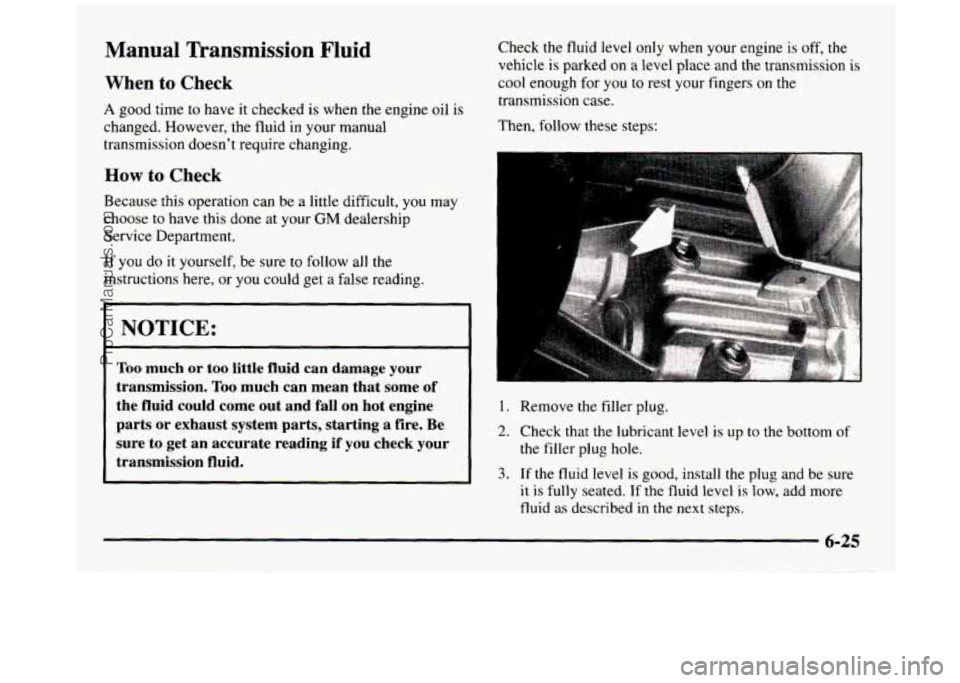
Manual Transmission Fluid
When to Check
A good time to have it checked is when the engine oil is
changed. However, the fluid
in your manual
transmission doesn’t require changing.
How to Check
Because this operation can be a little difficult, you may
choose to have this done at your
GM dealership
Service Department.
If you do it yourself, be sure to follow all the
instructions here, or you could get a false reading.
NOTICE:
Too much or too little fluid can damage your
transmission.
Too much can mean that some of
the fluid could come out and
fall on hot engine
parts or exhaust system parts, starting
a fire. Be
sure to get an accurate reading if
you check your
transmission fluid.
Check the fluid level only when your engine is off, the
vehicle is parked on
a level place and the transmission is
cool enough for you to rest your fingers on the
transmission case.
Then, follow these steps:
1. Remove the filler plug.
2. Check that the lubricant level is up to the bottom of
3. If the fluid level is good, install the plug and be sure
the
filler plug hole.
it
is fully seated. If the fluid level is low, add more
fluid as described
in the next steps.
ProCarManuals.com
Page 302 of 436
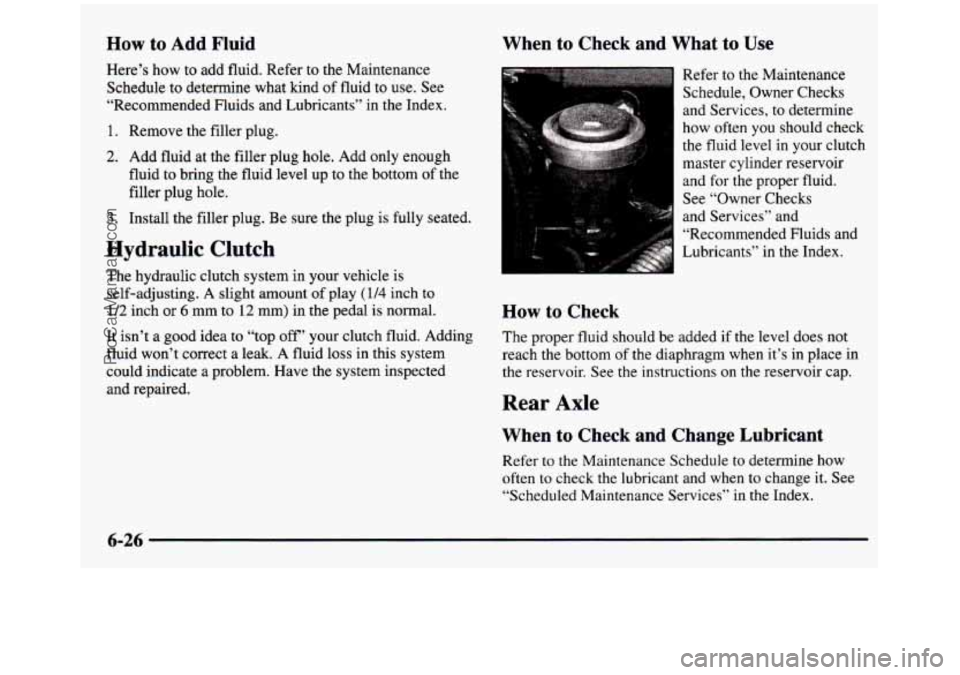
How to Add Fluid When to Check and What to Use
Here’s how to add
fluid. Refer to the Maintenance
Schedule to determine what kind of fluid to use. See
“Recommended Fluids and Lubricants” in the Index.
1. Remove the filler plug.
2. Add fluid at the filler plug hole. Add only enough
fluid to bring the fluid level
up to the bottom of the
filler plug hole.
3. Install the filler plug. Be sure the plug is fully seated.
Hydraulic Clutch
The hydraulic clutch system in your vehicle is
self-adjusting.
A slight amount of play (114 inch to
1/2 inch or 6 mm to 12 mm) in the pedal is normal.
It isn’t
a good idea to “top off’ your clutch fluid. Adding
fluid won’t correct
a leak. A fluid loss in this system
could indicate a problem. Have the system inspected
and repaired. Refer
to the Maintenance
yk I Schedule, Owner Checks
and
Services,
to determine
how often you should check
the fluid level in your clutch
master cylinder reservoir
and for the proper fluid.
See “Owner Checks
and Services” and “Recommended Fluids and
Lubricants” in the Index.
How to Check
The proper fluid should be added if the level does not
reach the bottom of the diaphragm when it’s in place in
the reservoir. See the instructions on the reservoir cap.
Rear Axle
When to Check and Change Lubricant
Refer to the Maintenance Schedule to determine how
often
to check the lubricant and when to change it. See
“Scheduled Maintenance Services” in
the Index.
6-26
ProCarManuals.com